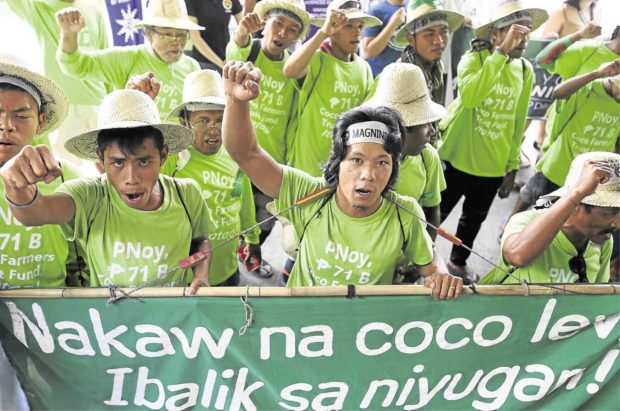Farmers hail coco levy ruling but fear setback in Congress

GIVE IT BACK Coconut farmers from Davao rally outside the Philippine Coconut Authority office in Quezon City in November 2014 demanding that P71 billion collected from them over the past four decades be returned to poor farmers. They fear their legal victory this week could be undercut by a bill in Congress.
Coconut farmers on Friday welcomed the Sandiganbayan decision to enforce the 2012 Supreme Court ruling that said P83 billion worth of assets acquired through the use of the coconut levy fund belonged to them.
“The Sandiganbayan order is timely in the light of the continuous drop in the price of copra. What is important is that the small coconut farmers will finally reap the benefits from the levy fund,” Exmar Ramos, leader of Kilusang Magbubukid ng Bondoc Peninsula, said in a statement.
Jansept Geronimo, spokesperson for Kilusan Para sa Tunay na Repormang Agraryo at Katarungang Panlipunan (Katarungan), said the farmers had long been waiting for the Sandiganbayan decision.
“The Sandiganbayan should not reach any other decision that is different from the one that the [high court] had,” Geronimo said.
In its 14-page resolution dated Aug. 7, which was made public on Thursday, the Sandiganbayan finally ordered the enforcement of the Supreme Court’s 2012 landmark decision declaring that P83 billion in assets acquired through the Coconut Industry Investment Fund (CIIF) were owned by the government for the benefit of coconut farmers.
Marcos tax
The CIIF was the surplus of the taxes imposed by the late dictator Ferdinand Marcos on coconut farmers. Instead of being used to improve the plight of the poverty-stricken farmers, the funds were invested instead in various corporations.
The recovered levy fund is expected to benefit more than 20 million coconut farmers and their families from about 21,000 coconut-producing villages across the country.
In accordance with the Sandiganbayan ruling, the following assets would be transferred to the government: six companies known as the CIIF Oil Mills Group (CIIF-OMG), their 14 holding companies and the holding companies’ 753.85 million shares of stock worth P71.04 billion in the conglomerate San Miguel Corp. (SMC).
All the income, interest and profits from the assets, as well as dividends from the SMC shares after Sept. 17, 2009 and proceeds from the redemption after Oct. 5, 2012, also would be covered by the Sandiganbayan ruling.
The antigraft court reiterated the Supreme Court’s order that the reconveyed assets “be used only for the benefit of all coconut farmers and for the development of the coconut industry.”
Appeals junked
The Sandiganbayan’s decision set aside appeals by the United Coconut Planters Bank (UCPB) and the United Coconut Planters Life Assurance Corp. (Cocolife) for more hearings to assess the Supreme Court’s ruling’s effect on their investments in the CIIF companies.
UCPB claimed its investments in the CIIF-OMG and its assets would be prejudiced by the execution of the Supreme Court ruling, while Cocolife argued that it would lose P7 billion of its P9.076-billion net worth and be forced to close. UCPB and Cocolife also claimed 11.03 percent and 11.01 percent of the SMC shares, respectively.
The antigraft court ruled that the issue of ownership had been “settled with finality.”
“The only thing left for determination of the court is the matter of execution of judgment,” it said.
Malacañang on Thursday urged the implementation of the Sandiganbayan’s ruling.
“There’s a writ of execution, it has to be enforced,” said presidential spokesperson Harry Roque. “The President is for the rule of law. If there’s a writ of execution, then enforce it.”
Who should manage fund?
However, some farmers feel that their legal victory already suffered a major setback even before it was announced, citing last week’s approval by a congressional bicameral conference committee of the Senate version of a bill that would create the coconut levy trust fund to be managed by the Philippine Coconut Authority (PCA).
Under the bill, the PCA’s governing body would be reconstituted with 11 members—four representatives from the government, one from the industry and six coconut farmers. They would manage the trust fund that would come from the national budget and the P105-billion coconut levy fund.
Rene Cerilla, one of the convenors of Kilus Magniniyog, lamented that it would be the PCA’s governing body that would utilize, manage and administer the fund instead of a Coconut Trust Fund Committee (CTFC), which coconut farmers have long been pushing for.
“This means our struggle might yet again be extended before poor and small coconut farmers gain benefit from the coco levy,” Cerilla said.
5-hectare limit
Danny Carranza, Katarungan secretary general, expressed concern over the deletion of the “5-hectare limit” in the definition of a coconut farmer beneficiary in the approved bill.
Carranza said the “same farmers” during the Marcos regime could resurrect themselves as representatives of the small coconut peasants in the PCA and regain control of the coconut levy fund.
“Hope it will not happen again,” Carranza said.
Geronimo appealed to President Duterte to fulfill his election campaign promise to return the coconut levy fund to the coconut farmers.
“Most of them (are) now old, sick and dying while waiting to benefit from the money which was forcibly collected from them during the Marcos dictatorship,” Geronimo said.
In a “pledge to the small coconut farmers” he signed during the 2016 campaign, Mr. Duterte promised he would ensure that coconut farmers would benefit from the coconut levy funds within the first 100 days of his administration. —WITH A REPORT FROM JULIE M. AURELIO